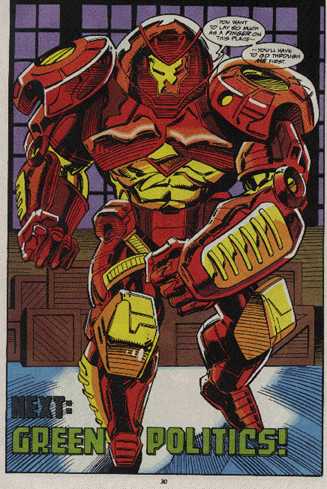Originally Published by Justin Mohareb in Dragon Magazine # 180.
Scenario two (from the MARVEL SUPER HEROES game): Tony Stark, as Iron Man, fights Firepower and receives several damaging blows. Tony is beaten senseless and flies his undamaged armor at top speed to his nearby helicopter. Notice the difference? In the MARVEL SUPER HEROES game, armored battlesuit combat should be handled differently to reflect damage incurred to the armor during combat, and to better represent the unusual abilities of an armored hero. The system in this article showcases an alternate method of generating and playing high-tech armored characters. DAMAGING ARMOR To add depth to armored combat, each power - including Body Armor - and each of the FASE ability modifiers is assigned a number as part of a random-roll table. These numbers will determine which of the armor's systems are damaged when an attack exceeds the suit's Body Armor (or applicable Force Fields, etc.) by more than +1CS, as noted later. The numbers should be arranged so as they can be rolled on a simple die: 1d8, 1d10, 1d12, etc. Optionally, assign two or more numbers on such a table to a power that would have a greater chance of being damaged, like Body Armor or Flight, depending on your vision of the character's armored suit and the placement of his weaponry and equipment. We now get to the raison d'etre for this expanded for this expanded system: armored suit combat. Every time the character is in combat and receives a blow that inflicts more damage than his Body Armor rank, the character takes damage equal to the amount of damage minus the amount absorbed by his body armor. For example, if a hero has Remarkable (30) Body Armor and is hit by an Incredible (40) rank Force bolt, the hero takes 10 points of damage (40 - 30 = 10). This is per the normal rules. If the damage is 2CS or more than the Body Armor rank, the character takes the appropriate damage, and percentile dice are then rolled on the rank of the attack -4CS to determine if the character's armor was damaged by the attack. For example, if the hero as above with Remarkable (30) Body Armor was punched by a villain possessing Amazing (50) Strength, the hero would take 20 points of damage and would roll 1d100 on the Good (10) column (50 - 4CS = 10). If the result is red, then roll on Table 3. Energy attacks are a special case, as Body Armor is 20 points less effective against energy attacks than against physical ones. When a hero is hit by an Energy attack capable of breaching the armor's reduced rank vs. Energy attacks, the character must follow the procedure for determining armor damage from physical attacks as before. Armored heroes can take Resistance to Energy Attacks to cover this weakness. REPAIRING DAMAGE Fixing damaged armor is relatively simple. The hero must make a Reason FEAT roll to make to proper repairs correctly. A Resources FEAT roll might be called for as well, to see if the hero can afford to make the repairs. Other strictures can be applied to the roll at the Judge's whim. It is often a good idea for the Judge to make the Reason FEAT roll for the hero in secret. That way, if the roll is a failure by a narrow margin - say, within five points of the number needed for success - the hero may mistakenly believe that his armor is repaired when it actually might fail at an important moment. This is a nasty thing to do, but I leave the decision whether or not to use this up to each Judge. ARMORED ADVANCEMENT The player may, at some point in his hero's career, attempt to modify the hero's armor by adding new powers. Armor powers can be added, up to the maximum number that was determined at creation, by spending 3,000 Karma for each, plus 10 times the starting rank number for that power (this is also the formula by which robots can add powers). Power advancement is done normally, by spending 10 points times the current rank plus 500 points for cresting from one rank to another. A Reason FEAT roll should be called for, with the difficulty equal to the new rank, if an old power is being advanced to a new, higher rank or if a new power is set at its starting level. A Resource FEAT roll might also be needed to see if the hero has the cash to perform the modifications. The Judge should make his own rulings on how to do the "total makeover" that's so popular with armored heroes, including such things as resetting Popularity to zero, upping appropriate powers and FASE abilities one rank, or adding new things. This should cost a great deal: about 10,000 Karma points, a high Resource FEAT roll (Amazing or better), and access to high-tech equipment or a high (Incredible or better) Reason FEAT roll. (This is, of course, up to the individual Judge.) All other forms of advancement are performed normally. Creativity is the key to any successful and enjoyable role-playing game. This system can only get you started on the way. Where you go now is up to you.
|
 Scenario one (from the Iron
Man comic book): Tony Stark, as Iron Man, fights Firepower and receives several damaging
blows. Tony is beaten senseless and has his armor nearly destroyed, so he has to fly
warily to his nearby helicopter.
Scenario one (from the Iron
Man comic book): Tony Stark, as Iron Man, fights Firepower and receives several damaging
blows. Tony is beaten senseless and has his armor nearly destroyed, so he has to fly
warily to his nearby helicopter.